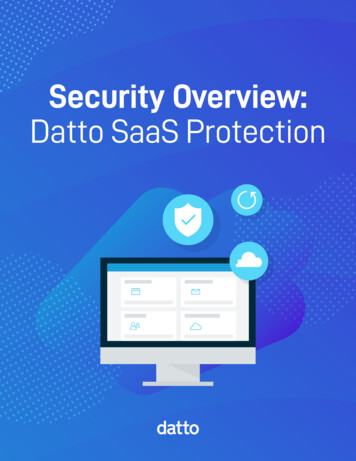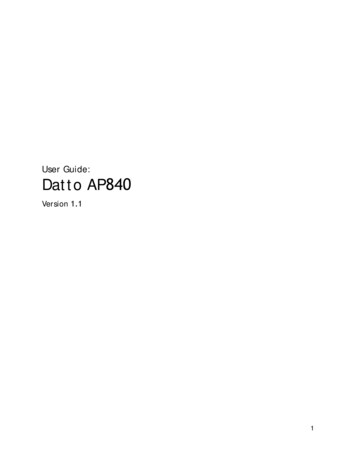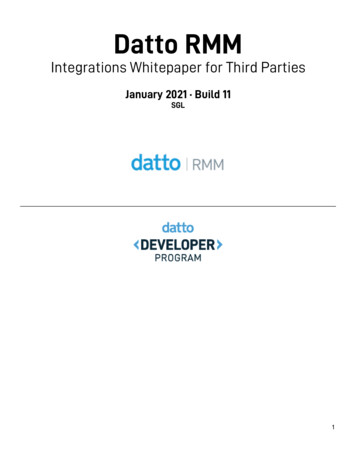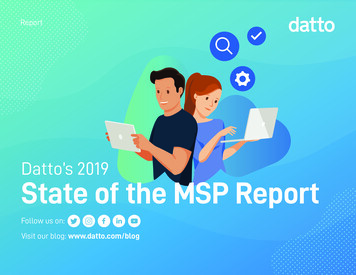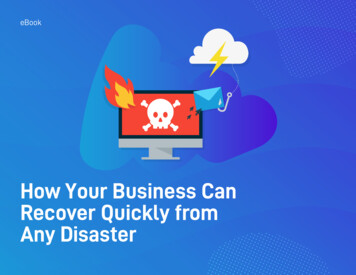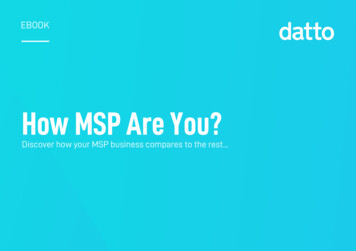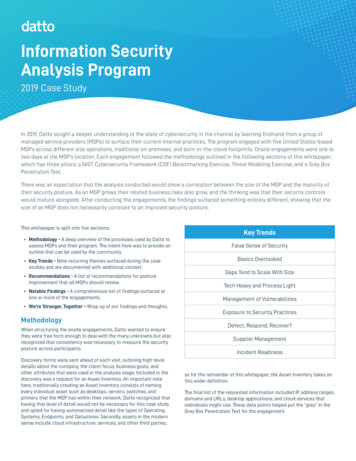
Transcription
Information SecurityAnalysis Program2019 Case StudyIn 2019, Datto sought a deeper understanding of the state of cybersecurity in the channel by learning firsthand from a group ofmanaged service providers (MSPs) to surface their current internal practices. The program engaged with five United States-basedMSPs across different size operations, traditional on-premises, and born-in-the-cloud footprints. Onsite engagements were one totwo days at the MSP’s location. Each engagement followed the methodology outlined in the following sections of this whitepaper,which has three pillars; a NIST Cybersecurity Framework (CSF) Benchmarking Exercise, Threat Modeling Exercise, and a Grey BoxPenetration Test.There was an expectation that the analysis conducted would show a correlation between the size of the MSP and the maturity oftheir security posture. As an MSP grows their related business risks also grow, and the thinking was that their security controlswould mature alongside. After conducting the engagements, the findings surfaced something entirely different, showing that thesize of an MSP does not necessarily correlate to an improved security posture.This whitepaper is split into five sections: Methodology - A deep overview of the processes used by Datto toassess MSPs and their program. The intent here was to provide anoutline that can be used by the community. Key Trends - Nine recurring themes surfaced during the casestudies and are documented with additional context. Recommendations - A list of recommendations for postureimprovement that all MSPs should review. Notable Findings - A comprehensive list of findings surfaced atone or more of the engagements. We’re Stronger, Together – Wrap up of our findings and thoughts.MethodologyWhen structuring the onsite engagements, Datto wanted to ensurethey were free form enough to deal with the many unknowns but alsorecognized that consistency was necessary to measure the securityposture across participants.Discovery forms were sent ahead of each visit, outlining high-leveldetails about the company, the client focus, business goals, andother attributes that were used in the analysis stage. Included in thediscovery was a request for an Asset Inventory. An important notehere, traditionally creating an Asset Inventory consists of namingevery individual asset such as desktops, servers, switches, andprinters that the MSP has within their network. Datto recognized thathaving that level of detail would not be necessary for this case studyand opted for having summarized detail like the types of OperatingSystems, Endpoints, and Datastores. Secondly, assets in the modernsense include cloud infrastructure, services, and other third parties,Key TrendsFalse Sense of SecurityBasics OverlookedGaps Tend to Scale With SizeTech Heavy and Process LightManagement of VulnerabilitiesExposure to Security PracticesDetect, Respond, Recover?Supplier ManagementIncident Readinessso for the remainder of this whitepaper, the Asset Inventory takes onthis wider definition.The final list of the requested information included IP address ranges,domains and URLs, desktop applications, and cloud services thatindividuals might use. These data points helped put the “grey” in theGrey Box Penetration Test for the engagement.
NIST Cybersecurity FrameworkOne of the three pillars of the engagement was the use of theNational Institute of Standards and Technology (NIST) CybersecurityFramework (CSF) for a benchmarking exercise. The NIST CSFwas created to serve as a guideline for US-based private sectorbusinesses to assess their ability to prevent, detect, and respond tocyber incidents. Version 1.1 of the framework contains 5 Functions, 23Categories, and 108 Subcategories.Initially, each Subcategory was scored using the Tier definitions setby NIST. However, this proved to be problematic and challenging toscore in some situations. NIST created the Tier model to apply to theCategories themselves. Applying Tiers to the testing Subcategoriesleads to some undesirable outcomes. After some research, theengagements moved to an approach suggested by Jack Jones, awell-respected leader in information security and risk management,to measure Subcategories using a two-dimensional scale. Fortransparency, below are the definitions used how the rating systemscored each Subcategory:Capability ClaimSubcategory RatingStrong345Partial234123UnsubstaniatedPolicies &ProcessesConfidenceValidatedWeakFigure 1Capability Claim Strong: The Subcategory is both highly effective and has beenimplemented throughout most, if not all, of the organization Partial: The Subcategory is either highly effective butimplemented across only a minority of the organization, or is inplace throughout the organization but is marginal in its efficacy Weak: The Subcategory has either not been implemented at all, oris partially implemented and marginally effectiveConfidence Validated through Testing: An independent party has evaluatedthe capability more than once, and at least once within the pastyear, and found it to align with the rating. Substantiated by Policies and/or Processes: The organization hasformally defined expectations regarding the capability (usuallythru policies and/or processes) that help to reduce the likelihoodof the capability being ineffective or not meeting expectations. Unsubstantiated: There are no formal policies or processesthat formally establish expectations for this capability, whichincreases the likelihood of it being ineffective.datto.comThe combination of Capability Claim and Confidence derived thefinal score for the Subcategory, as shown in Figure 1. The first twoengagements were rescored using this approach, and the remainingengagements enjoy the ease by which this facilitated the conversation.Conducting these served as the best means to understand andsurface data used in the next pillar, the Threat Modeling Exercise. It’sworth noting at this point, NIST CSF is risk-based, and in practice,a smaller MSP would not have the same level of risk as a largeMSP. Having various levels of risk can translate into differencesbetween companies who use NIST and is why Datto’s use of the termbenchmark is explicit here. While companies within the same peergroup can share the scoring, a smaller MSP and a larger MSP shouldnot compare themselves. Instead, a benchmark allows businesses towork through improvements to their program, and in 6 months to ayear, step through the process to measure themselves again.ThreatsBefore stepping through the Threat Modeling Exercise, it is worthdiscussing Threats, those targeting MSPs, and their clients. In moretraditional terms, a Threat Actor is an individual or a group that isseeking to cause harm by leveraging a Vulnerability resulting in a systemCompromise. For the remainder of this paper, Threats are simply thespecific attack scenarios MSPs face against their environment.TacticTechniqueATT&CK IDDrive-by CompromiseInitial AccessT1189Exploit Public-FacingApplicationInitial AccessT1190External Remote ServicesInitial AccessT1133Spearphishing AttachmentInitial AccessT1193Spearphishing LinkInitial AccessT1192Spearphishing via ServiceInitial AccessT1194Supply Chain CompromiseInitial AccessT1195Valid AccountsInitial Access,Persistence,Privilege EscalationT1078PowerShellExecutionT1086Third-party SoftwareExecutionT1072User ExecutionExecutionT1204Brute ForceCredential AccessT1110Credentials from WebBrowsersCredential AccessT1503Credentials in FilesCredential AccessT1081Application DeploymentSoftwareLateral MovementT1017Remote Access ToolsCommand andControlT1219Standard Application LayerProtocolCommand andControlT1071Data Encrypted for ImpactImpactT1486Information Security Analysis Program - 2019 Case Study2
The Threat Modeling Exercise focused on real scenarios playing outacross the channel in 2019 and a mix of recent tactics seen in thewild. The table below summarizes the techniques attackers use thatDatto focused on during the case studies. These techniques and IDsare from the MITRE ATT&CK Framework. Additional information canbe found at https://attack.mitire.org and is worth reviewing to gain adeeper understanding of how adversaries operate in the real world.Grey Box Penetration TestUpon completion of the Threat Modeling exercise, each participantranked the top five vulnerabilities surfaced during the exercise.The group collectively shared their top five findings and providedguidance on what and where to focus on immediately following theend of the engagement. It was the end of this exercise that all thediscussions came together and often provided the aha! momentswith participants.In terms of operating rules, a live Slack channel was open duringthe exercise and if Datto uncovered something sensitive, a check-inoccurred before proceeding. The exercise did not include phishing,given the effort required for standing up the targeted infrastructurefor each participant. Finally, while breaking into personal accountsof employees was off-limits, account credentials found in pastbreaches were in scope to be used against business systems. This isa common tactic used by attackers. In the real world, threat actorsdo not see a line between the work and personal, using everythingthey can to meet their objectives.The exercises fell short of actually calculating Risk, meaning therewas no calculation of financial loss. NIST 800-37 uses the formula“Risk Assets x Threat x Vulnerability,” where Assets have a valuethat can be lost, and a Threat is the “thing” exploiting the Vulnerabilityidentified. Calculating financial loss is a highly individualized process,and that was beyond the scope of the engagement. The mitigationsprioritized for participants were considered foundational securitypractices, in many cases, basics that apply to all environments.Further discussion on these is found later in this paper.Threat ModelingMany formal methods exist for modeling cyber threats againstan application, infrastructure, or the business environment. Giventhe engagement timing, Datto took a less formal approach to theexercise. The Datto exercise involved creating an architecturediagram of infrastructure and services from the Asset Inventory data,identifying boundaries of internal networks, customer connectivity,and integrated connections within the tech stack. In some cases,this process took fifteen minutes and in the larger environments wellover an hour to enumerate. In all cases, a full map was never createdbefore by a participant. Figure 2 is an example of a less complicatedmap. Having created the architecture diagram, we stepped throughthese scenarios to review the controls in place and enumerate thevulnerabilities that exist for the MSP. Despite taking a less formalapproach to the exercise, these discussions proved to be invaluable.In parallel to the NIST CSF Benchmark and the Threat Modelingexercise, the participants had a tightly scoped Penetration Test aspart of the engagement. Taking the collected information in thediscovery phase, a senior member of Datto’s Penetration Testingteam began testing on the participant’s infrastructure.The workflow followed by the penetration tester was fairly standard.Collected data enabled the first step, enumerating the infrastructureto determine what vulnerabilities exist. While Datto was provided alist of IP Ranges for efficiency reasons, any motivated individual can(and does) enumerate a list on their own. Second, the penetrationtester created a list of known employees from websites, socialmedia, and any other source. Various accounts and email addresseswere passed through a collection of over a billion compromisedaccounts, traded on the underground forums. This helped surfacecompromised credentials and other accounts that might have beenmissed in the initial research. Lastly, scans of the IP addresses andinfrastructure provided a list of possible vulnerability targets toexplore for exploitation.Key TrendsThroughout the case studies, Datto identified several findings thateventually became trends based on the frequency by which theywere identified. Some of these trends were informed by the NIST CSFBenchmark summary data.Figure 3: The visualization provides summary views into subcategoryrating scoring, collected through the Benchmarking Exercises.The three views capture the Capability Claim, Confidence, andcalculated Overall Rating, outlined in Figure 1. The Subcategories (108) for each were rolled up to their respectiveCategories (23), with a normalized score between 0 to 1. Across all participants, the distribution of the Category scoreswere mapped to the three views. The darker the color, the higher concentration of scores.False Sense of SecurityFigure 2datto.comAcross the board, there was a false sense of security across manycontrols and the overall posture of a participant’s environment.The NIST CSF Identify Function helps understand the businessenvironment and guide the risk-based decisions. It was typical forCategories as part of this Function to score higher than the others.Information Security Analysis Program - 2019 Case Study3
Category12312312345IdentifyAsset yBusiness ifyRisk yRisk Management upply Chain Risk Identity Mgmt, Auth. & Access reness and ta fo. Protection Processes & tProtective nomalies and ity Continuous etection esponse erRecovery ability ClaimConfidenceOverall RatingFigure 3 - NIST Cybersecurity Benchmark SummarySimilarly, the Protect Function had a higher average, withparticipants claiming they protected their assets. Protect covers theimplementation and maintenance of assets and data, something thataligns very closely with the MSP model.However, when working through the Threat Modeling exercises thecase studies identified that the confidence of controls was lackingand were not always universally implemented.Basics OverlookedAttack vectors widely reported in the media were found in participantenvironments. External exposure of Remote Desktop Protocol, singlefactor authentication for VPN and critical cloud services, and reuseof a single credential for all client environments was present despitethe significant uptick in the media over the last year.Gaps Tend to Scale with SizeDatto expected that as an MSP grew in size and revenue that therewould be a correlation in the investments to the technology stack.datto.comThe thinking was the program would be stronger and more matureas a result. While spending on technology increased, what wassurprising is that the maturing MSPs who invested in technology hadmore exposure due to misconfigurations, data and access sprawl,and systems left by technicians who no longer work at the company.The frequency of these concerns correlated to the size of the techstack of an MSP.Tech Heavy and Process LightThe NIST CSF Benchmark Summary shows participants that haveinvested in tooling had a stronger technology Capability Claim inthe Protect Categories, covering things such as Identity & AccessManagement, Network, and Endpoint Security. The Confidence,however, in these Subcategories were relatively Unsubstantiated.Lower Confidence highlights that implemented technical controlsoften lacked the supporting processes to ensure effectiveness.Controls such as two-factor authentication (2FA) were inconsistentlyimplemented and firewalls were leveraging default settings. Thesesettings included signatures set to only detect threats and had noactivity logging enabled. In discussions with the MSPs, the reasoningInformation Security Analysis Program - 2019 Case Study4
fell into a few categories; limited resources, limited knowledge, or afalse sense of security from their technology.Management of VulnerabilitiesA few MSPs had the ability to run vulnerability scans for themselves,but no MSP performed regular scans of their external\internalinfrastructure or had a process in place for remediation. ThePenetration Test enumerated several external vulnerabilities acrossmultiple engagements. With enough time, the exploitation of severalMSP assets on the internet would be possible.Exposure to Security PracticesWhile working through the NIST CSF Benchmark with many of theMSPs, Datto, on average, spent three to four hours to complete theone hundred and eight questions. MSPs required a primer for eachSubcategory of NIST CSF and often required walking through theenvironment for examples for a fulsome understanding. The majorityof MSPs later, stepping through the Threat Modeling Exercise helpedconnect the dots of the missing controls and the net effect on thesecurity program. The engagements highlight a few things. First,MSPs can pick up these concepts rather quickly when presentedwith the right context and information. Secondly, most MSPs lackexposure to mature security programs, peers, or the ideals of a goodprogram. Lastly, the global cybersecurity talent shortfall that existshits MSPs as experienced talent migrate towards upmarket roles thatcommand larger salaries.Detect, Respond, Recover?As the previous finding surfaced, the majority of MSP attention forNIST CSF focuses on the first and second Categories; Identify &Protect, respectively. What was most surprising is that the Detect,Respond, and Recover Functions receive little to no attention.Outliers here were the MSPs who had an incident that forcedmaturity in a Category. Additionally, those who had a higher CapabilityClaim in the Analysis or Mitigation Categories had missing care &feeding or analysis processes when it comes to genuinely satisfyingcontrols. MSPs rely on protective technologies and invest less indetective tools and processes that catch Threats that slip past singlelayer tools like traditional antivirus.Supplier ManagementWhen pressed on the Subcategories for Supply Chain Management,MSPs show a high-level of trust for their suppliers. In almost allcases, MSPs have never conducted due diligence of the provider’scontrols and security posture. MSPs need to approach this witha Trust-but-Verify mindset. Attacks on the supply chain meantechnology suppliers, Datto technology included, are targets andvectors for potential attacks. MSPs should perform additional duediligence of the technology and services they are using to managetheir clients.Incident ReadinessWhen speaking with MSPs on the Subcategories related to BusinessContinuity and Incident Response, the responses mostly indicatedthat in the face of an incident, actions would be ad hoc in nature.datto.comMeaning, not one MSP had a documented plan (large or small) withthe steps for if critical services were not available or an attackoccurred. Reasons noted were the size of the staff, lack of time, orbeing dismissive of the value of such a plan.RecommendationsThe recommendations below are the summary of actions that MSPsshould be taking and are a result of the case study’s efforts. As noted,the security program of an MSP will be look different based on therisks it faces. Prioritize accordingly, and don’t take on the entire listat once.The Cobbler’s Children Need Shoes, TooThe old saying about the cobbler’s children having no shoes comesfrom serving the needs of clients rather than taking care of their ownhouse. The case studies show that MSPs protect their customersmore effectively than themselves. Given the rise of targeted attackson MSPs this should raise concern. These are motivated attackersthat are seeking to gain access to meet an objective, in many casestaking over tooling to ransom as many endpoints as possible. MSPsneed to ensure their own house is in order when it comes to securityto protect themselves and their clients.Security Requires Continuous ImprovementIt is essential to get into the mindset that information securityrequires continuous improvement. Successful outcomes requiremore than a set-it-and-forget-it approach. Threats are continuallyevolving, and what was secured yesterday can be vulnerable today.MSPs should get to a level of comfort with their security posture butnever sit back as if it is complete.Implementing a technology or tool in your environment needs to bemore than working through the administration guide. Documentationhas a cost in lost time at a client site; it was by far the most commonresponse received. But investing in technology and not receivingthe full return on investment is not exactly good business practice.Ensure processes for managing the tools are documented androutinely executed.Create goals for the program that are reasonable and attainable.Balancing the challenges that come with running a business meansprioritizing the things MSPs need to do, and mindfully deprioritizingthose that can wait. Information security is no different. When facedwith a long list of security improvements, take the top five and workthrough those until they are complete. Review the list and repeat theprocess, don’t tackle the whole list at once. It’s worth noting that itshould be an evolving list; it’s a continuous process.Continuous Improvement in Practice: An MSP made an investment inan endpoint detection and response (EDR) platform for their practice.A few months later an MSP hired a managed security serviceprovider (MSSP) to conduct a penetration test of their environmentwhich turned up a handful of problems with Active Directory. In thisscenario the MSP should both fix the Active Directory gaps, as wellas ensuring that the exact scenario is detectable in the EDR platformin the future. It’s the continual improvement to the environment andtools that will lead to better outcomes.Information Security Analysis Program - 2019 Case Study5
Honesty is the Best PolicyMove Beyond Protective ControlsWhen reviewing your security posture, it does little good to overstatethe coverage of your security controls as well as the effectivenessthey have in your environment. Being honest and having the dialoguethat comes along will lead to better and more secure outcomes.As Datto worked through the engagements with MSPs, participantsembraced the findings and worked them into future plans. Thisprovides positive insight into the willingness of MSPs to have thehonest conversations.Many MSPs include security controls that are primarily preventative.MSPs also gravitate towards controls that are easy to use and havea lower management cost. The more time to manage them, the lesstime they have to grow the business, so this makes sense. Inherentin this mix of tools are lower false positives, but that opens thepossibility of lower detection rates. Detective controls understandthat not everything is preventable. They provide insight into theenvironment that helps surface threats lurking in business systems.This recommendation and “Seek Guidance” go hand-in-hand. Enlistthe services of a MSSP to conduct penetration testing for yourenvironment to help get an honest, unbiased perspective. Having athird party provides a level of accountability that can be difficult toreplicate with just internal staff.The team over at Perch has created a “Weighted Decision Matrix”for analysis by MSPs that are seeking to move beyond protectivecontrols. You can work through the spreadsheet with any typeproduct or class of control, adjust ratings, and add features orfunctionality that are important to your business and service offering.Identity ManagementHarden Your Email ServicesThe need to implement 2FA cannot be understated. If a tool used inyour tech stack offers 2FA or moving to your single sign-on platform,implement it today. The case study shows that MSPs are leavingcritical systems with passwords, API keys, and documentation storesopen without strong authentication.The case studies conducted surfaced a number of controls gapswhen it comes to email security. In the 2019 State of the ChannelRansomware Report, Datto identified 67% of ransomware attacksuse phishing as the tactic. MSPs need to take note on the followingimprovements to help reduce the risks of email delivery:Having accounts to manage the various tools of a tech stack requiresmultiple logins and keeping track of them all is painful. For solutionsthat support it, look to implement a unified identity platform thatallows you to integrate your solutions into a single identity. UnifiedIdentity shortens your staff on-boarding and off-boarding times andlowers the time each day your techs spend logging into their toolswhile enforcing a common set of policies.Implement SPF, DKIM, and DMARC to your business email tosignificantly improve email security. The case studies conductedsurfaced a number of controls gaps when it comes to email security.Spoofing of emails can help attackers exploit trust between MSPsand clients; an individual is more likely to click on a link or open a filefrom a recipient. The amount of SPAM received by a user also factorsinto the problem. Higher volumes of email numb and lowers thevigilance one has on vetting phishing emails.Not every technology provider supports single single-on, so individualaccounts and passwords will be necessary. Ensuring that eachaccount has a different password can be a tedious task, but in theend, it can significantly reduce the likelihood of Credential Stuffingor Password Spraying attacks. There are several channel and nonchannel password management offerings. Standardize on an optionfor your business. There are even options for sharing credentialsamongst the team.As part of the process of gaining access to a target environment,attacks look into personal accounts that someone might haveand search out the passwords in breach dumps, just like businessaccounts. In some cases, your personal accounts are a means to gainaccess to your worklife. Be sure to use unique passwords and use2FA on critical personal accounts.There is an unknown number of underground marketplaces andpublic services where password information can be purchased. Enlista service that surfaces the compromised credentials from the darkweb so that you can be aware of system compromises. Using theunique password strategy will also help you better identify the sourceof the credentials.datto.comAdd an advanced filtering layer to the basic email protection suiteincluded with Gmail or Office 365.Harden Your EndpointsThere are several things you can do to harden your endpoint devices.Create a standardize secure baseline configuration for your user andserver assets and apply these via your RMM. The Center for InternetSecurity provides some excellent materials on secure standards,apply what makes sense for your environment. If you don’t usePowerShell, disable it. If customers don’t use Macros, disable them inMicrosoft Office. The 2019 Verizon DBIR identified 45% of the malwareattacks used a Microsoft Office document as the delivery file type.An additional resource that is worth reading was released by NinjaRMM in July of this year, 2019 Cybersecurity Checklist: PracticalSteps for Securing your MSP Business. This checklist includes anumber of endpoint considerations as well as a great list of othersworth reviewing.Information Security Analysis Program - 2019 Case Study6
Segment Your NetworkBase the network segmentation approach around the needs ofyour business. At a minimum, break out the Guest Network ontoan isolated VLAN. Having untrusted visitor devices on the networkalongside customer management systems is poor practice. For largeror more mature shops: Break out server assets and testing labs onto isolated networks. Isolate tech workstations from non-tech workstations, serverassets from client workstations. Segment third party vendor access through VPNs and appliedleast privileged to the access they have to your network. Validate the policies after implementation to ensure effectiveisolation between segments.Implement Vulnerability Management PracticesManaging vulnerabilities on the external and internal networksshould be a priority. Yet, not a single MSP in the case study had avulnerability management program internally. Running occasionalscans is not enough; successful outcomes require a repeatable andmanaged process that remediates critical findings promptly.Be PreparedThe absolute last thing an MSP should be doing during an incidentis figuring out what they actually need to be doing. The amountof adrenaline pumping through the body means decision-makingprocesses are affected. Critical actions are timely, and there is littletime to decide what to do during an incident. Additionally, CyberInsurance Policies often have requirements that, if missed, couldresult in not getting paid out.Brian Weiss of ITECH Solutions who suffered through a ransomwareattack shared “Create an incident response plan, even if it is just abullet point or a check list. Some of the 25-50 page or overly doneincident response plans tend to get glazed over in times of stress.”Spending the afternoon with the team on a Friday and think through ascenario such as ransomware hitting your network.Seek GuidanceAn
Grey Box Penetration Test In parallel to the NIST CSF Benchmark and the Threat Modeling exercise, the participants had a tightly scoped Penetration Test as part of the engagement. Taking the collected information in the discovery phase, a senior member of Datto's Penetration Testing team began testing on the participant's infrastructure.
